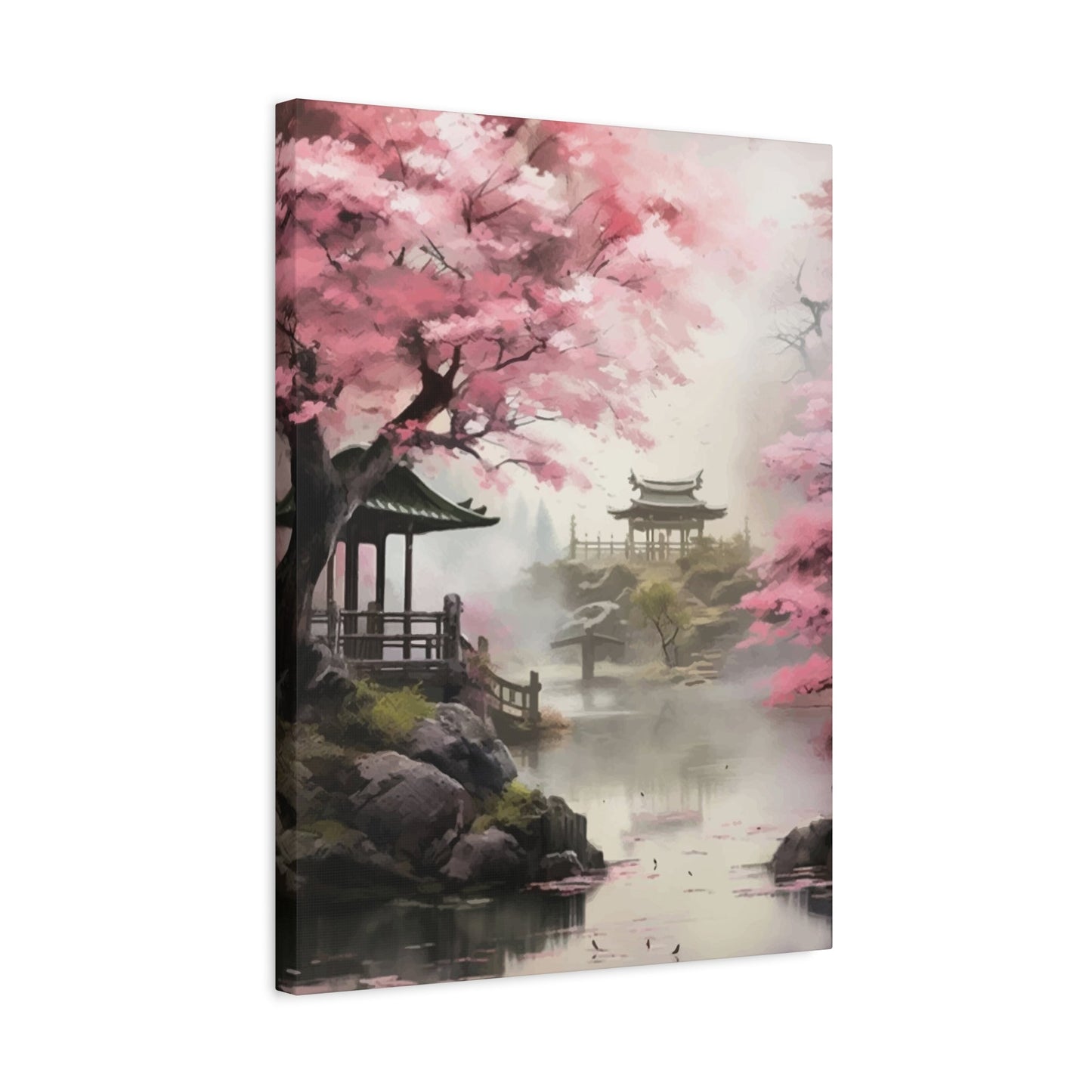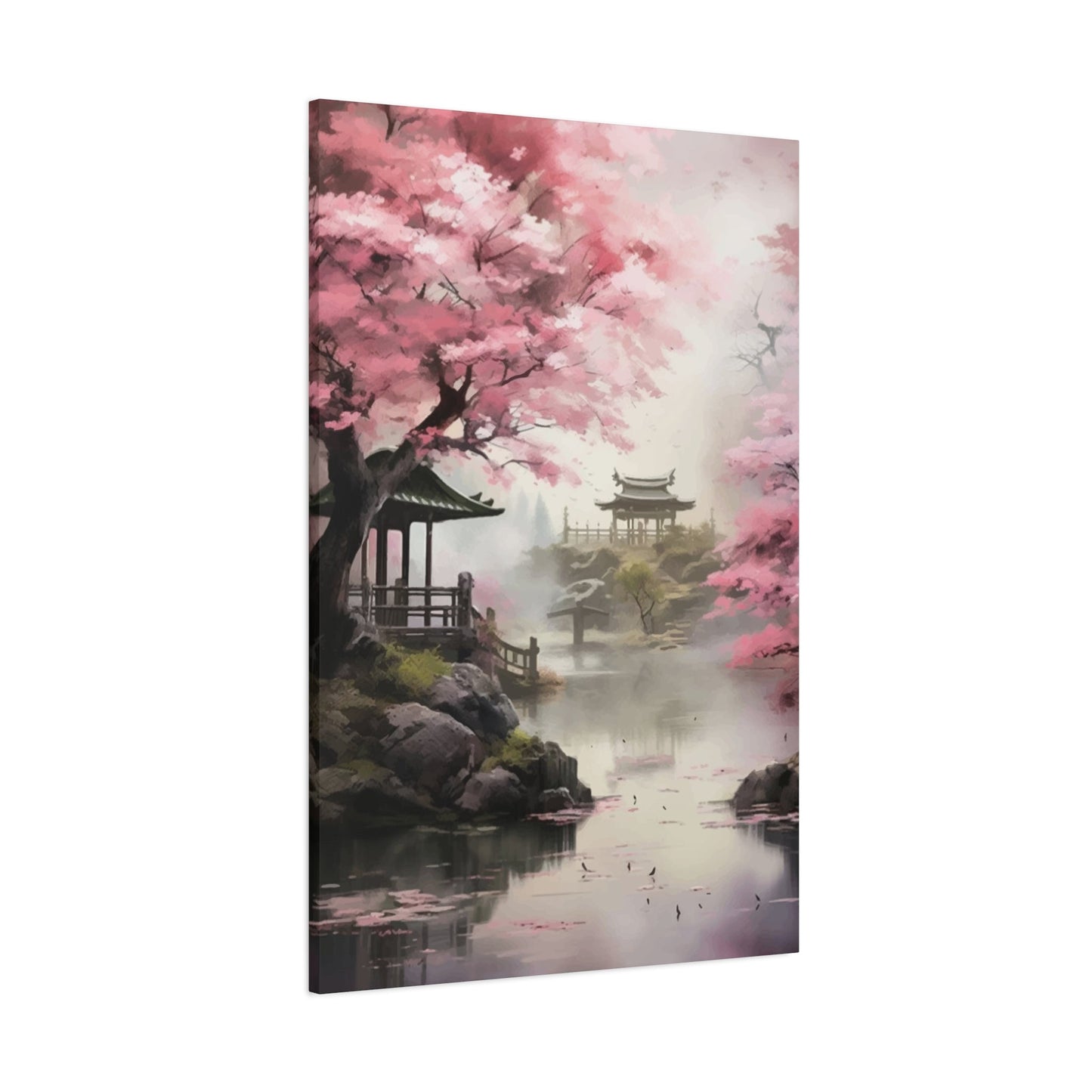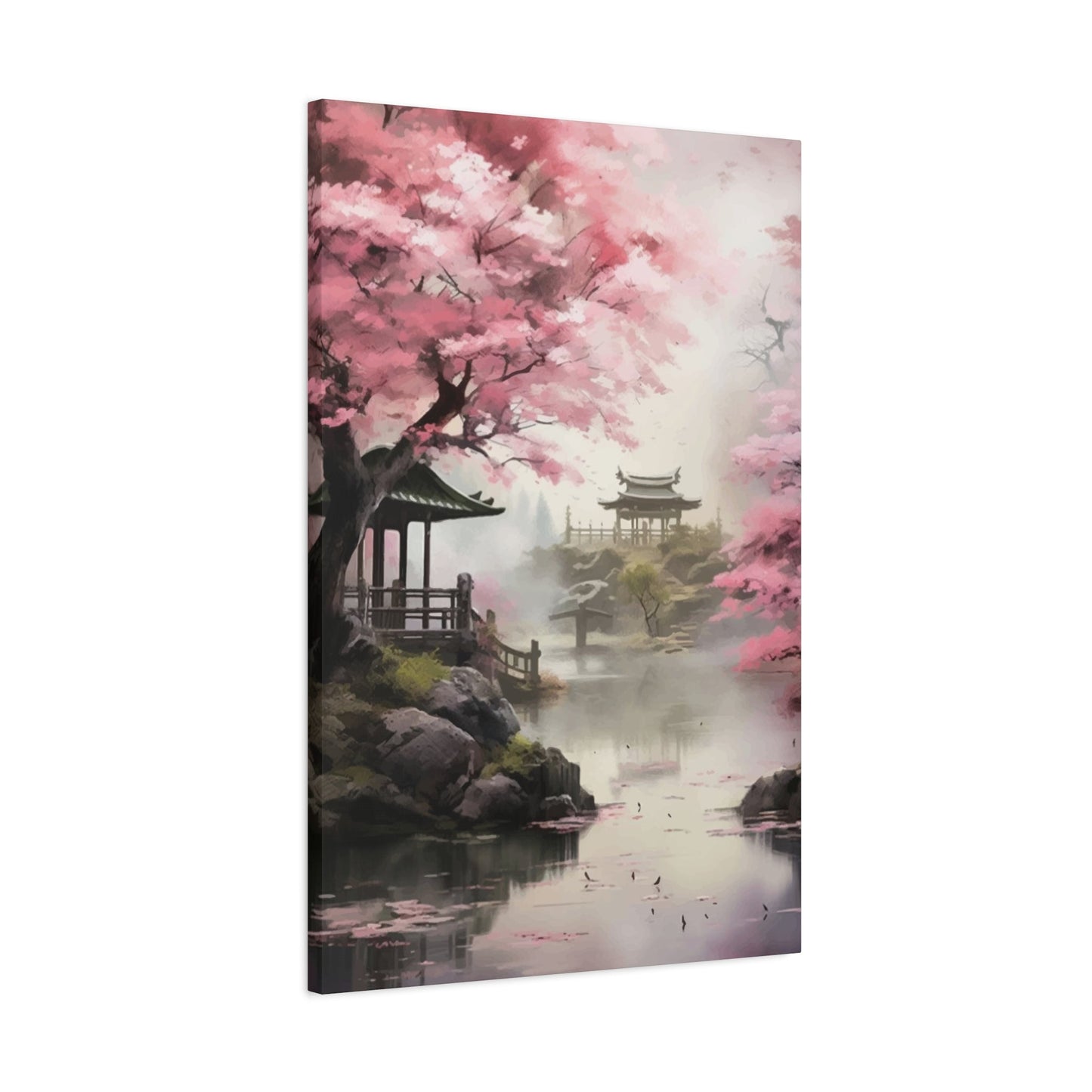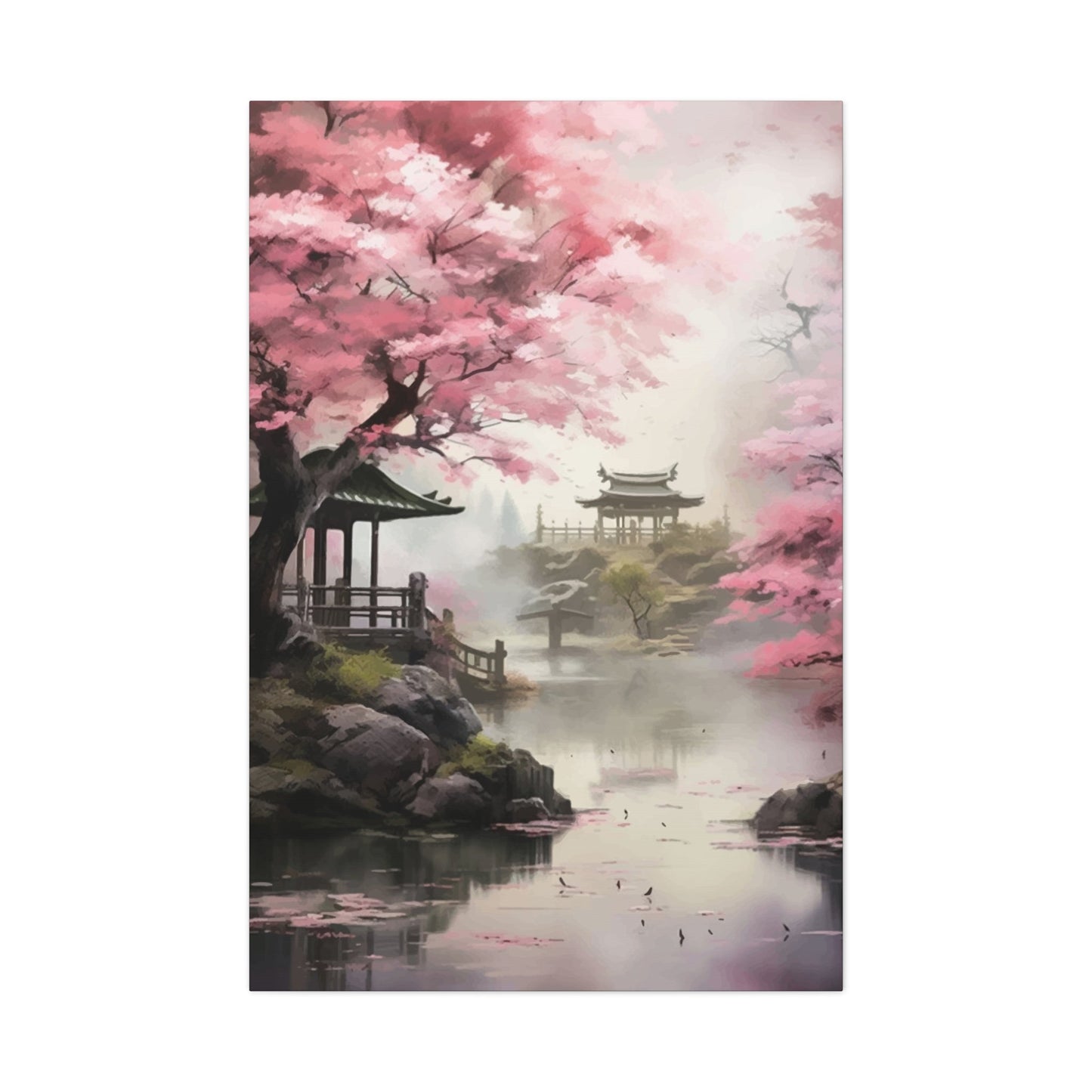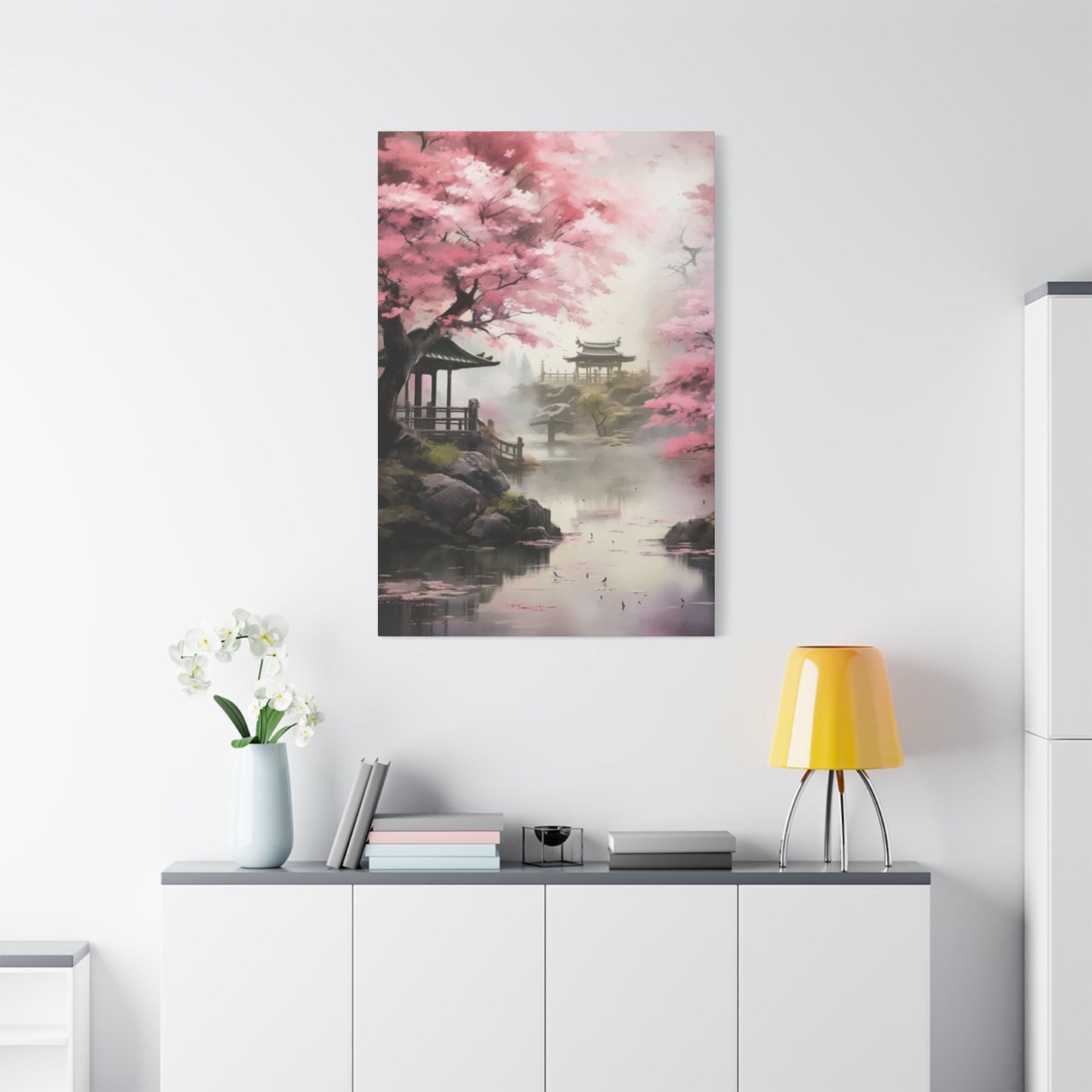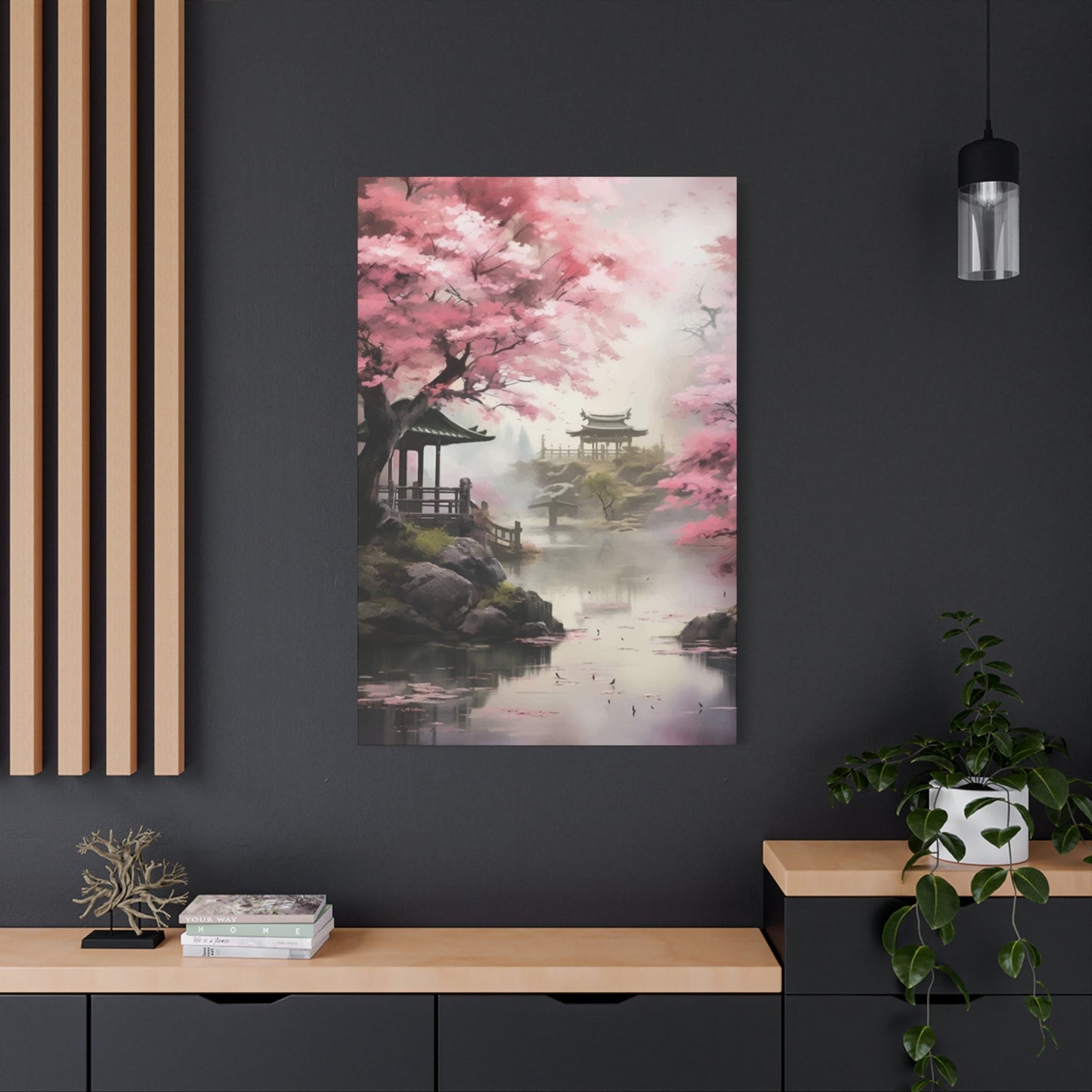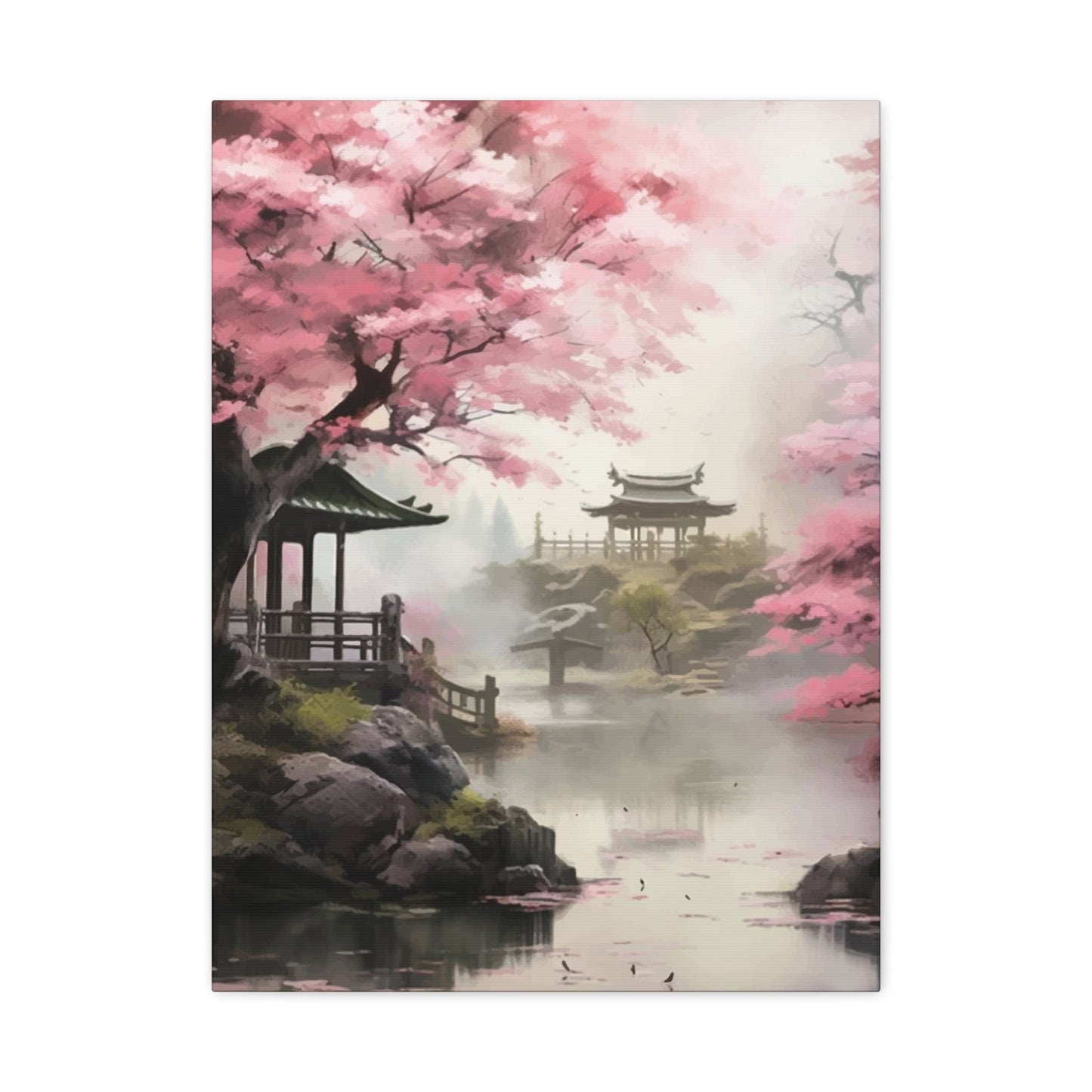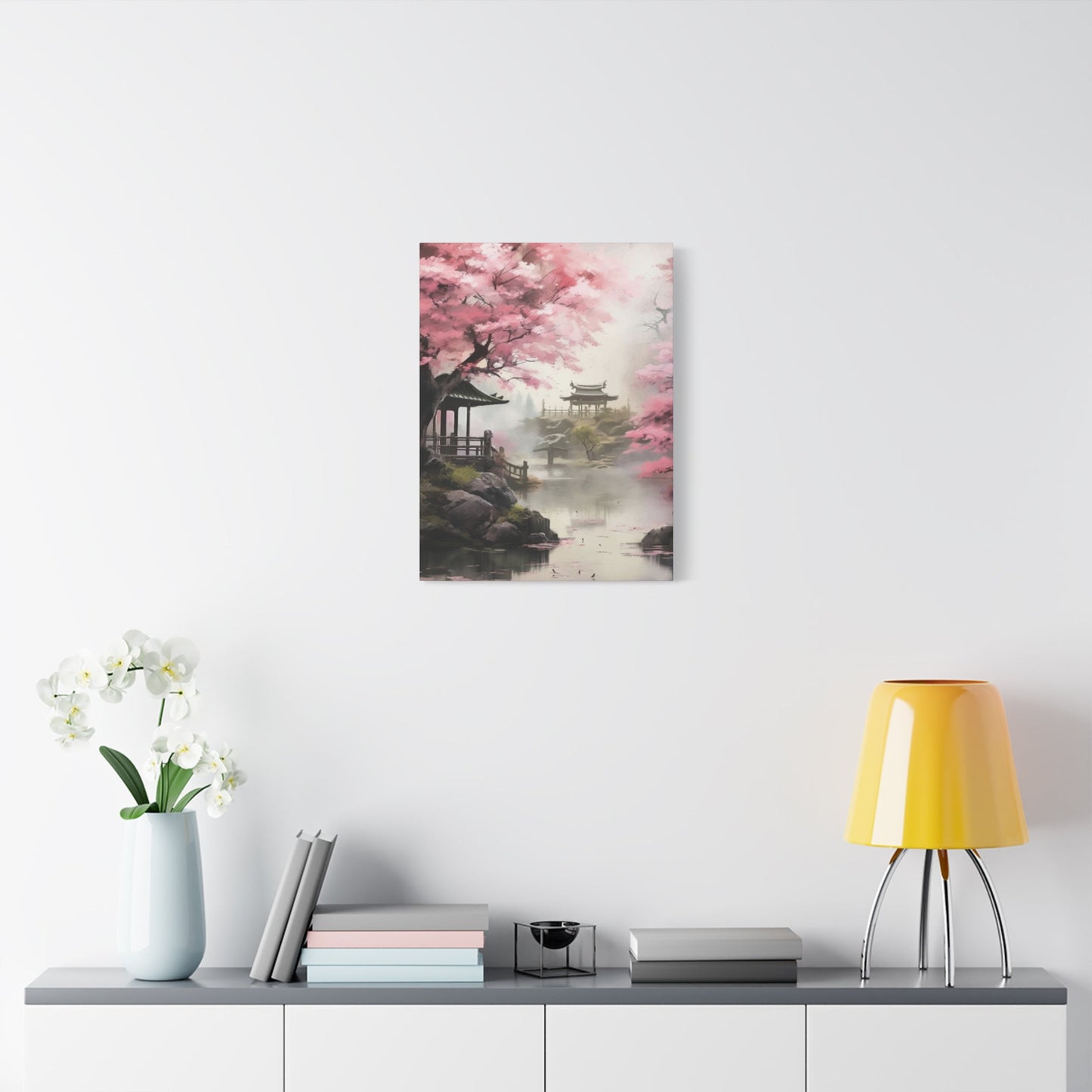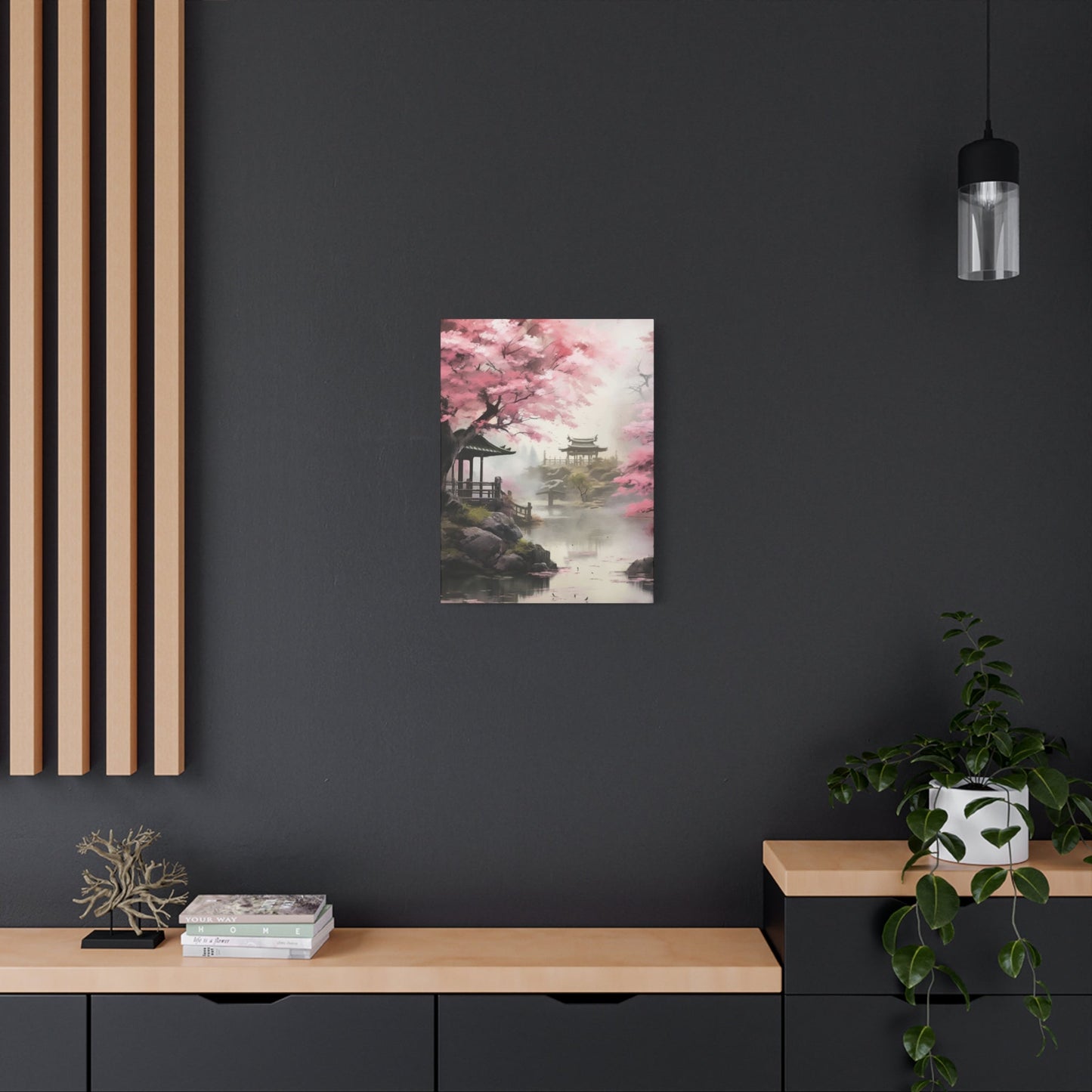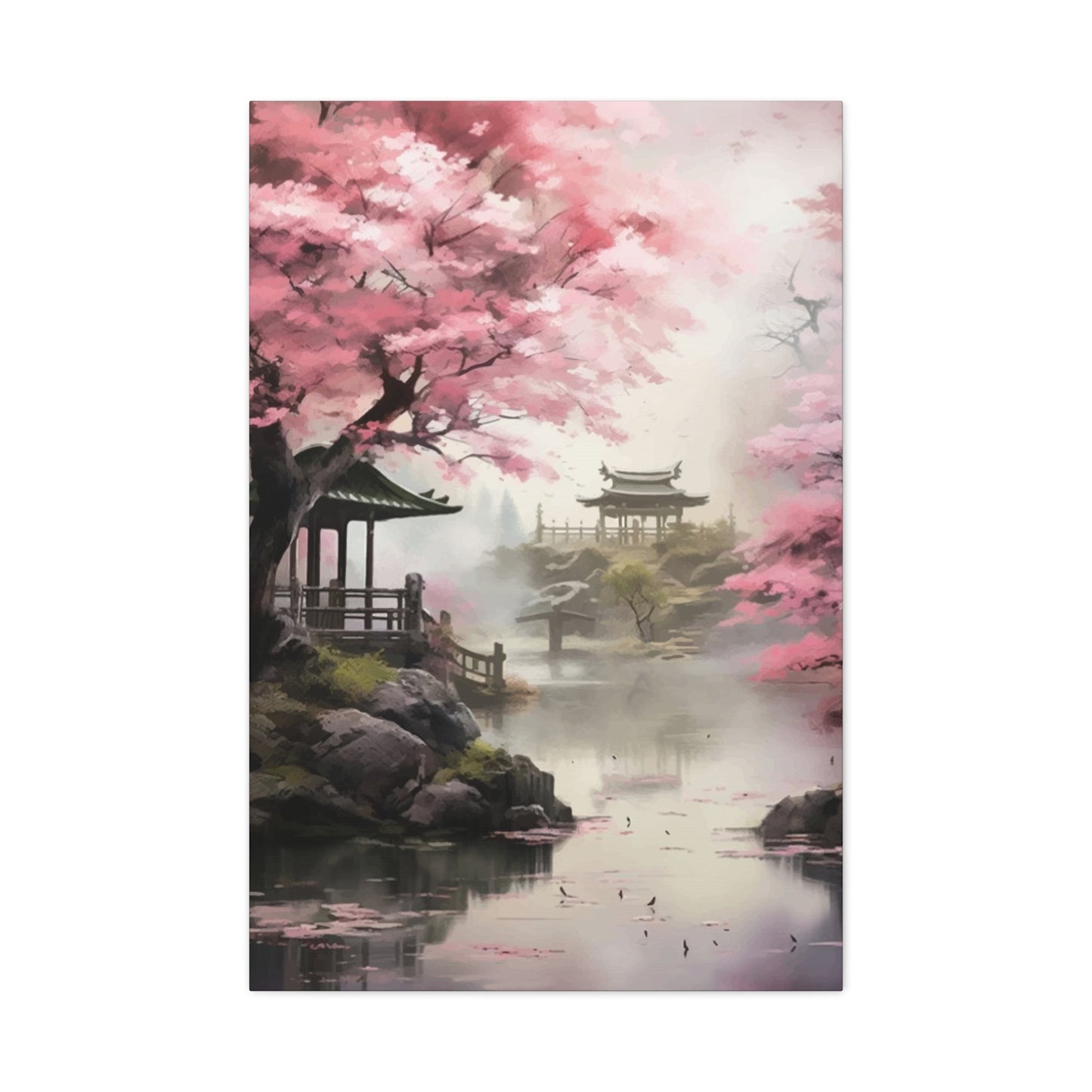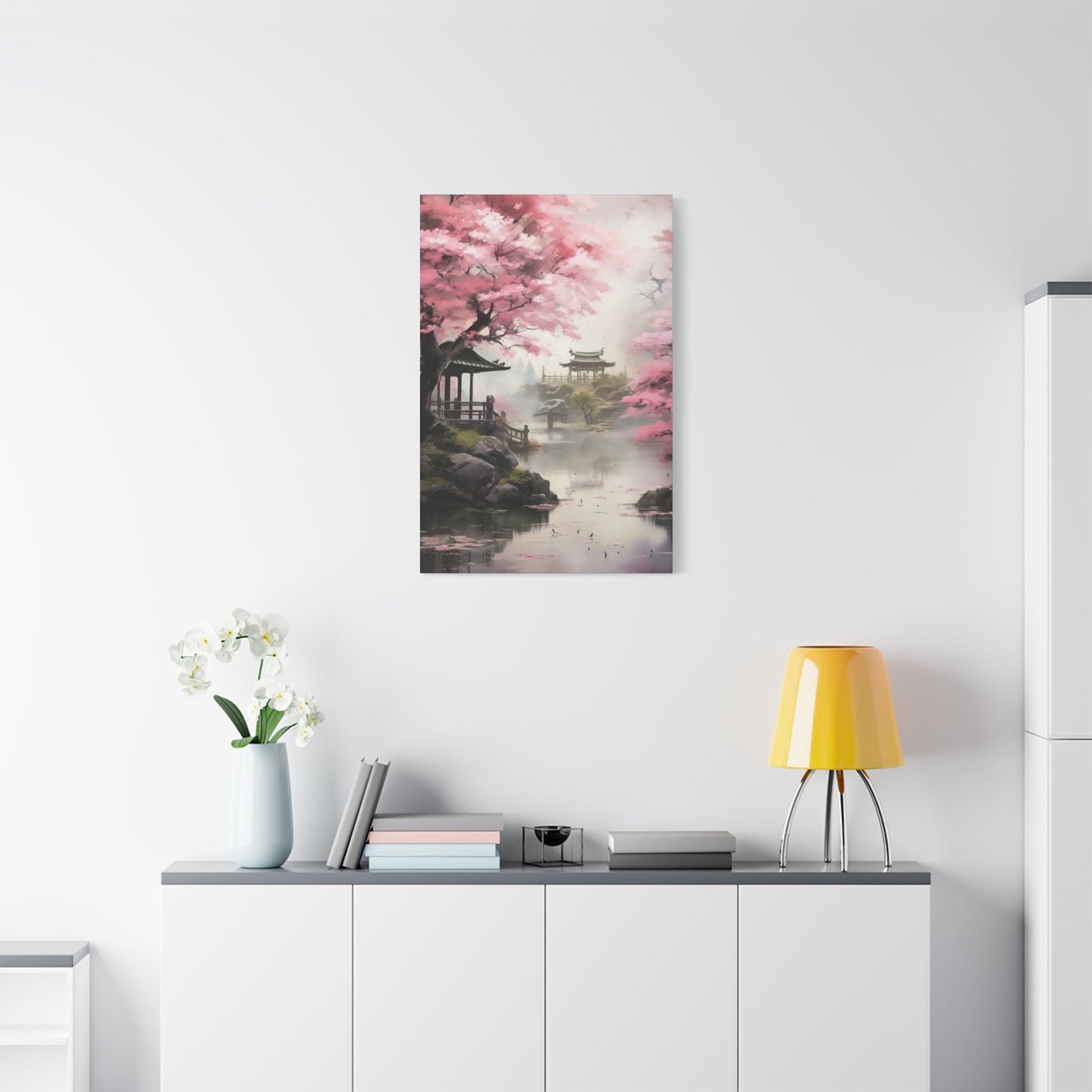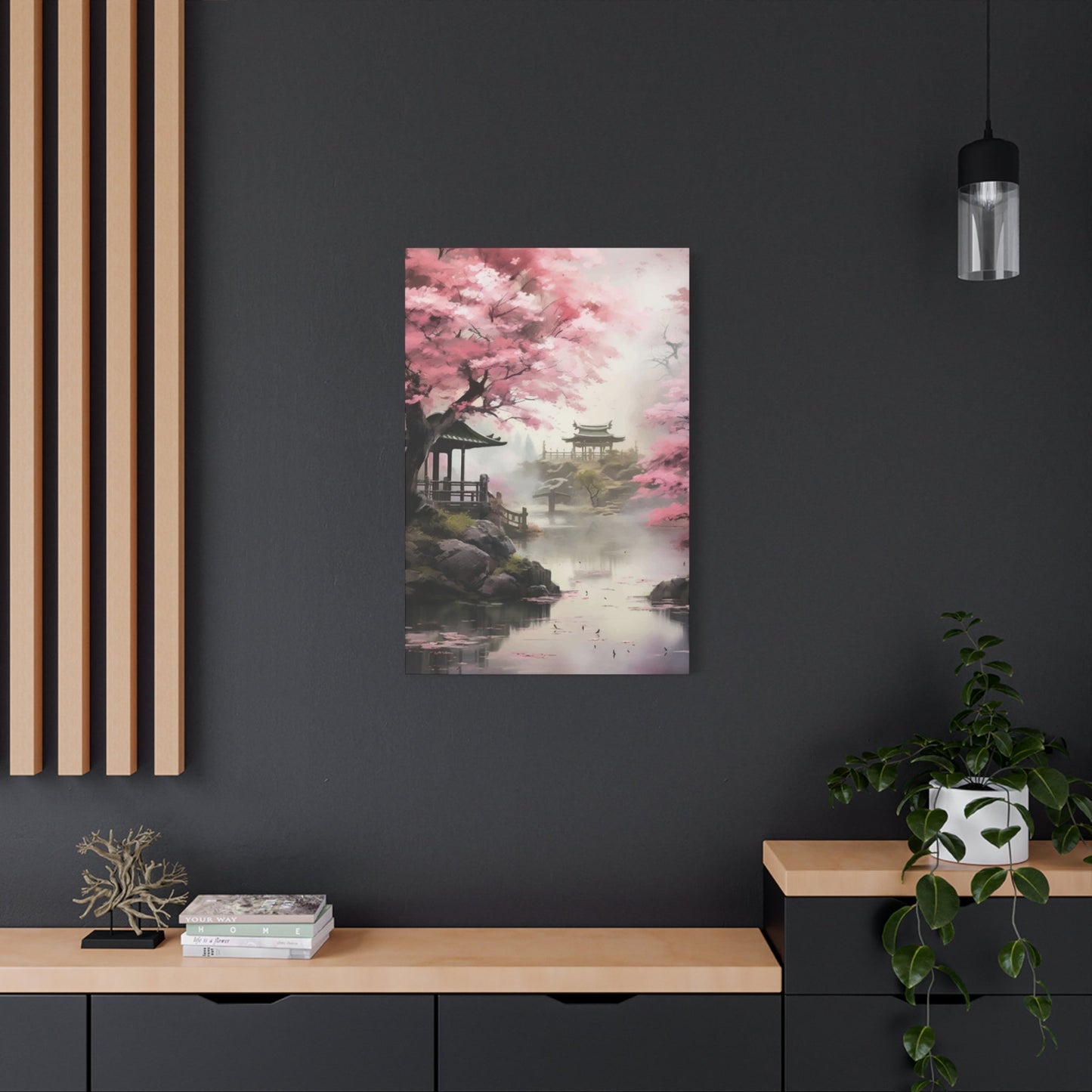Japanese Landscape Wall Art: Bringing Zen Philosophy Into Modern Living
Japanese landscape wall art represents far more than decorative elements for modern homes. These artistic expressions embody centuries of philosophical traditions, spiritual practices, and cultural wisdom that have shaped Japanese society. The foundation of Japanese landscape artistry rests upon ancient principles that view nature not as something to be conquered or dominated, but as a harmonious partner in existence.
The concept of mono no aware, often translated as the pathos of things, permeates every brushstroke of traditional Japanese landscape paintings. This philosophical principle acknowledges the transient nature of all things, finding beauty in impermanence and melancholy in the inevitable passage of time. When artists create mountain scenes shrouded in mist or cherry blossoms floating on gentle breezes, they capture these fleeting moments that remind viewers of life's precious temporality.
Wabi-sabi, another fundamental Japanese aesthetic principle, celebrates imperfection and impermanence as sources of beauty. This philosophy appears in landscape wall art through asymmetrical compositions, weathered textures, and the deliberate embrace of empty spaces that Western art might consider incomplete. The philosophy suggests that true beauty emerges not from perfection but from accepting the natural cycles of growth, decay, and renewal that govern all existence.
The influence of Zen Buddhism cannot be understated in Japanese landscape artistry. Zen practitioners seek to achieve enlightenment through direct experience rather than intellectual understanding, and this approach manifests in artwork that prioritizes feeling and intuition over realistic representation. Artists working within this tradition often spend years studying single subjects – perhaps a particular mountain or seasonal transformation – to capture not just visual appearance but the essential spirit of their subject.
Japanese landscape wall art also reflects the Shinto belief system, which recognizes the presence of spiritual essence in natural features like mountains, rivers, and forests. This animistic worldview treats landscapes not as inanimate backdrops but as living entities deserving of reverence and respect. When contemporary artists create pieces inspired by Mount Fuji or the forests of Kyoto, they tap into this ancient understanding of nature as sacred and alive.
The historical development of Japanese landscape painting evolved through distinct periods, each contributing unique elements to the artistic tradition. During the Heian period, artists began developing distinctly Japanese styles that moved away from Chinese influences, creating more naturalistic representations of their homeland's unique geography and seasonal changes. The Kamakura and Muromachi periods saw the integration of Zen aesthetics, leading to more minimalist compositions that suggested rather than explicitly depicted natural scenes.
Traditional Techniques That Define Japanese Landscape Artistry
The technical mastery required for authentic Japanese landscape wall art involves understanding several specialized painting and printing techniques that have been refined over generations. Sumi-e, the art of ink wash painting, stands as perhaps the most recognized technique in Japanese landscape artistry. This method relies on varying concentrations of black ink to create gradations of tone and texture, requiring artists to master brush control and understand how ink behaves on different paper surfaces.
In sumi-e practice, artists must develop intuitive understanding of how much water to mix with ink to achieve specific effects. Light washes create misty mountain backgrounds that seem to dissolve into clouds, while concentrated ink defines foreground elements with bold, confident strokes. The technique demands years of practice to achieve the spontaneous appearance that characterizes master works, as any hesitation or correction becomes immediately apparent in the finished piece.
Woodblock printing, or ukiyo-e, represents another cornerstone technique in Japanese artistic tradition. This labor-intensive process involves carving separate blocks for each color in a composition, then printing them in precise registration to create the final image. Master carvers and printers worked together with artists to produce landscape prints that could be reproduced multiple times while maintaining artistic integrity and visual impact.
The woodblock printing process begins with the artist creating a detailed drawing on thin paper, which is then pasted face-down onto a cherry wood block. Skilled carvers use various tools to remove wood around the drawn lines, leaving raised areas that will hold ink during printing. Color separation requires creating additional blocks for each hue, demanding precise planning and execution to ensure proper alignment during the printing process.
Nihonga, meaning Japanese painting, encompasses traditional techniques using mineral pigments, natural brushes, and specialized papers or silk surfaces. This approach to landscape creation emphasizes subtle color harmonies and textures that cannot be achieved through other methods. Artists grind their own pigments from minerals like malachite for greens, azurite for blues, and cinnabar for reds, mixing these with animal glue binders to create paints with unique working properties.
The application of nihonga techniques requires understanding how different pigments interact with various surface preparations. Some minerals require multiple thin layers to achieve desired intensity, while others provide optimal color in single applications. Artists must also consider how different pigments age over time, selecting materials that will maintain their intended appearance for decades or centuries.
Paper selection plays a crucial role in Japanese landscape artistry, with different varieties providing unique textures and absorption qualities that affect the final appearance of artwork. Washi, traditional Japanese paper made from plant fibers, offers varying degrees of texture and absorbency depending on its manufacturing process and raw materials. Some papers accept ink quickly with soft, diffused edges, while others resist absorption, allowing for sharper, more defined brushstrokes.
Historical Evolution of Japanese Landscape Wall Art
The development of Japanese landscape wall art reflects broader cultural, political, and social changes that occurred throughout Japanese history. During the Asuka period, artistic expression was heavily influenced by Buddhist traditions imported from China and Korea, with landscape elements serving primarily as backgrounds for religious narratives rather than subjects worthy of independent attention.
The Heian period marked a significant transformation in Japanese artistic consciousness, as court culture began developing distinctly Japanese aesthetic sensibilities. Artists started paying greater attention to seasonal changes, weather patterns, and the emotional resonance of natural phenomena. This period saw the emergence of yamato-e, a painting style that celebrated Japanese landscapes and cultural themes rather than merely copying Chinese artistic conventions.
Political upheaval during the Kamakura period brought warrior culture to prominence, influencing artistic themes and patronage patterns. Landscape painting during this era often reflected the Buddhist concept of impermanence, with scenes of autumn leaves, winter snows, and spring blossoms serving as metaphors for the transient nature of political power and human ambition. Artists working under warrior patronage developed more austere styles that emphasized strength and endurance rather than courtly refinement.
The Muromachi period witnessed the golden age of Zen-influenced landscape painting, as powerful military leaders embraced Buddhist philosophy and aesthetic principles. Artists like Sesshū created revolutionary landscape compositions that reduced natural scenes to essential elements, using empty spaces and minimal brushstrokes to suggest vast mountain ranges and flowing rivers. This period established many of the compositional principles that continue to influence contemporary Japanese landscape wall art.
During the Edo period, the rise of merchant culture and urban populations created new markets for artistic expression. The ukiyo-e tradition emerged during this time, producing woodblock prints that made high-quality landscape images accessible to broader audiences. Artists like Hokusai and Hiroshige created iconic series depicting famous locations throughout Japan, establishing visual vocabularies for representing particular geographic features and seasonal phenomena.
The Meiji Restoration brought dramatic changes to Japanese society, including exposure to Western artistic techniques and philosophical approaches. Some artists embraced oil painting and realistic representation, while others worked to preserve traditional methods and aesthetic principles. This period saw the development of nihonga as a conscious effort to maintain Japanese artistic identity while incorporating selected elements from Western practice.
The twentieth century brought additional challenges and opportunities for Japanese landscape artists. Military conflict and social transformation created new contexts for artistic expression, while international recognition brought Japanese aesthetic principles to global attention. Contemporary artists working in traditional styles must navigate between maintaining authentic connections to historical practice and responding to modern cultural conditions.
Philosophical Foundations Shaping Modern Interpretations
Contemporary Japanese landscape wall art continues to draw inspiration from philosophical traditions that have shaped Japanese culture for over a millennium. The concept of ma, often translated as negative space or emptiness, remains central to modern compositions that rely on what is not painted to suggest what is present. This principle recognizes that emptiness possesses its own power and meaning, capable of evoking emotional responses as profound as any detailed representation.
Modern artists working within Japanese landscape traditions must understand how ma functions not merely as absence but as active compositional element. Empty areas in paintings create breathing room that allows viewers to project their own experiences and emotions onto the artwork. This participatory aspect of Japanese aesthetics invites contemplation and personal reflection rather than passive observation, transforming wall art from decoration into meditation aid.
The principle of kanso, meaning simplicity, guides contemporary artists toward eliminating unnecessary elements while preserving essential characteristics that define particular landscapes or seasonal moments. This approach requires developing refined judgment about which details contribute to overall impact and which merely add visual complexity without enhancing meaning or emotional resonance.
Achieving kanso in landscape wall art involves more than simply reducing the number of elements in a composition. Artists must understand the symbolic significance of various natural features and how different combinations create specific emotional effects. A single bird in flight might represent freedom and transcendence, while the same bird perched on a branch could suggest contemplation and rest.
The aesthetic principle of shizen, emphasizing naturalness and spontaneity, challenges contemporary artists to maintain fresh approaches to traditional subjects. This philosophy suggests that the most powerful artistic expressions emerge from direct, unmediated responses to natural phenomena rather than calculated attempts to create impressive technical displays. Artists working within this tradition often spend considerable time observing their subjects before attempting to capture them in permanent form.
Buddhist concepts of interdependence continue to influence how contemporary Japanese landscape artists approach their subjects. Rather than viewing mountains, rivers, and forests as separate entities, this philosophical framework recognizes the fundamental connections between all natural phenomena. Landscape paintings created within this understanding often suggest these relationships through compositional choices that unite different elements into cohesive wholes.
The influence of Confucian ethics appears in contemporary landscape wall art through emphasis on harmony, balance, and social responsibility. Artists working within this tradition consider not only the aesthetic impact of their work but also its potential influence on viewers' moral and spiritual development. This approach treats art creation as a form of social contribution rather than merely personal expression.
Color Psychology and Emotional Resonance in Japanese Art
The strategic use of color in Japanese landscape wall art serves purposes far beyond mere visual appeal, tapping into deep psychological associations and cultural meanings that have developed over centuries of artistic tradition. Traditional Japanese color theory recognizes that different hues can evoke specific emotional states, seasonal associations, and spiritual conditions, allowing artists to guide viewers toward intended psychological experiences.
The predominance of earth tones in Japanese landscape painting reflects both practical and philosophical considerations. Browns, ochres, and muted greens connect viewers to natural environments while avoiding the artificial brightness that might disturb contemplative states. These colors age gracefully, maintaining their visual harmony as pigments mature and papers develop patina over time.
Blue holds special significance in Japanese landscape artistry, representing both sky and water while symbolizing infinity, depth, and spiritual transcendence. Artists use various shades of blue to create atmospheric perspective, with lighter blues suggesting distant mountains and deeper blues indicating nearby water features. The careful gradation of blue tones can create the illusion of vast spaces within relatively small compositions.
Monochromatic compositions using only black ink and its various dilutions demonstrate the sophisticated understanding of tonal relationships that characterizes Japanese artistic tradition. These works rely on subtle variations in ink concentration to create complex spatial relationships and emotional effects without the distraction of competing colors. The resulting images often possess meditative qualities that encourage prolonged contemplation.
Seasonal color associations play crucial roles in Japanese landscape wall art, with specific hues triggering recognition of particular times of year and their associated emotional qualities. Spring compositions might feature pale pinks and fresh greens that suggest renewal and hope, while autumn scenes employ deeper reds and golds that evoke maturity and acceptance of natural cycles.
The psychological impact of empty spaces, rendered in the natural color of paper or silk, cannot be underestimated in Japanese landscape compositions. These unpainted areas often occupy significant portions of finished works, creating visual rest areas that allow viewers to process and absorb the painted elements without overwhelming sensory input. The interaction between painted and unpainted areas generates dynamic tensions that energize contemplative experiences.
Contemporary research in color psychology supports many traditional Japanese approaches to color usage in landscape art. Studies indicate that earth tones and muted colors can reduce stress levels and promote relaxation, while carefully balanced compositions help maintain viewer attention without causing fatigue. These findings validate centuries of intuitive understanding about color's impact on human psychology and well-being.
Regional Variations and Geographic Influences
Japanese landscape wall art exhibits distinct regional characteristics that reflect the diverse geography, climate, and cultural traditions found throughout the Japanese archipelago. Artists from different areas developed unique approaches to representing their local environments, creating recognizable stylistic variations that add richness and diversity to the overall tradition of Japanese landscape painting.
The mountainous regions of central Japan inspired artistic traditions that emphasize vertical compositions and dramatic elevation changes. Artists from these areas became particularly skilled at representing the interplay of light and shadow on steep slopes, the formation and movement of clouds around mountain peaks, and the seasonal transformation of high-altitude vegetation. These regional influences produced landscape paintings with strong upward movement and dynamic compositional structures.
Coastal regions contributed different aesthetic sensibilities to Japanese landscape art, with artists developing techniques for representing the constant motion of water, the interaction between sea and land, and the unique atmospheric conditions created by maritime environments. Coastal landscape paintings often feature horizontal compositions that emphasize the relationship between sky and sea, with land masses serving as transitional elements rather than dominant focal points.
The volcanic activity that characterizes much of Japan provided artists with dramatic subjects that required specialized techniques for representation. Artists working in regions with active volcanoes developed methods for depicting steam, ash clouds, and the unique geological formations created by volcanic activity. These regional specializations contributed to the overall vocabulary of Japanese landscape painting while reflecting local environmental conditions.
Northern regions of Japan, with their extended winters and dramatic seasonal contrasts, influenced artistic approaches to representing snow, ice, and the stark beauty of dormant landscapes. Artists from these areas became expert at using minimal color palettes to suggest the subtle variations in white and gray that characterize winter scenes, while also capturing the explosive vitality of brief but intense growing seasons.
The forested regions of Japan supported artistic traditions that focused on the representation of trees, undergrowth, and the filtered light conditions found beneath forest canopies. Artists working within these environments developed specialized brushwork techniques for suggesting different types of foliage and bark textures, while also learning to capture the spiritual qualities that Japanese culture associates with ancient forests.
Urban environments, particularly during the Edo period, created new contexts for landscape painting as artists responded to the growth of cities and the changing relationship between human settlements and natural environments. Urban-influenced landscape paintings often incorporated architectural elements and showed greater interest in the ways human activity modified natural settings.
Contemporary Applications and Modern Adaptations
Modern applications of Japanese landscape wall art principles extend far beyond traditional painting and printmaking into diverse contemporary contexts that maintain authentic connections to historical aesthetic traditions while addressing current cultural needs and preferences. Digital technologies have opened new possibilities for creating and distributing Japanese-inspired landscape art, allowing artists to reach global audiences while preserving essential characteristics of traditional approaches.
Digital art creation tools enable contemporary artists to experiment with traditional Japanese landscape techniques while incorporating modern capabilities for color manipulation, texture creation, and compositional refinement. Software applications can simulate traditional brush behaviors and ink flow patterns, allowing artists to create works that capture the spontaneous quality of sumi-e painting while providing opportunities for precise control and modification that traditional media cannot offer.
Print-on-demand technologies have democratized access to high-quality Japanese landscape wall art, enabling artists to offer their work in various sizes and formats without requiring large initial investments in inventory or production facilities. These technologies also allow for customization options that can adapt traditional landscape themes to specific architectural requirements or personal preferences while maintaining aesthetic integrity.
Contemporary architectural contexts present new challenges and opportunities for Japanese landscape wall art applications. Modern building designs often feature clean lines and minimal ornamentation that complement traditional Japanese aesthetic principles, creating ideal environments for landscape artworks that emphasize simplicity and natural themes. Large-scale installations in commercial and residential buildings can transform sterile environments into spaces that promote contemplation and connection with nature.
The integration of lighting technologies with Japanese landscape wall art creates possibilities for dynamic presentations that change throughout the day or in response to environmental conditions. LED systems can subtly alter the appearance of artwork to simulate different times of day or seasonal conditions, enhancing the temporal aspects that are fundamental to Japanese landscape aesthetics.
Therapeutic applications of Japanese landscape wall art have gained recognition in healthcare settings, meditation centers, and wellness facilities. Research indicates that viewing nature-based artwork can reduce stress levels, lower blood pressure, and improve emotional well-being, making Japanese landscape pieces valuable tools for creating healing environments in institutional settings.
Educational institutions have embraced Japanese landscape wall art as teaching tools for introducing students to different cultural perspectives, aesthetic philosophies, and artistic techniques. Interactive displays can demonstrate the relationship between artistic choices and cultural values while providing opportunities for hands-on exploration of traditional methods and materials.
The Symbolism of Mount Fuji in Japanese Artistic Tradition
Mount Fuji occupies a unique position in Japanese landscape wall art, serving simultaneously as geographic landmark, spiritual symbol, and artistic challenge that has inspired countless interpretations throughout Japanese art history. The mountain's perfect conical form and sacred associations have made it perhaps the most recognizable subject in Japanese landscape painting, appearing in works ranging from ancient scroll paintings to contemporary digital art.
The spiritual significance of Mount Fuji predates its artistic representation, with Shinto traditions recognizing the mountain as the dwelling place of the fire goddess Konohanasakuya-hime. This religious association imbued artistic representations of Fuji with sacred qualities, transforming simple landscape images into objects of veneration and meditation. Artists working within this tradition understood their responsibility to capture not merely the mountain's physical appearance but its spiritual essence.
Hokusai's famous series "Thirty-six Views of Mount Fuji" established many of the compositional and symbolic conventions that continue to influence contemporary representations of the mountain. This series demonstrated how a single subject could be explored from multiple perspectives and under various conditions while maintaining coherent artistic vision and thematic unity. Each print in the series revealed different aspects of the mountain's character and its relationship to surrounding environments.
The seasonal transformation of Mount Fuji provides artists with opportunities to explore themes of impermanence and natural cycles that are fundamental to Japanese philosophy. Spring representations might show the mountain emerging from winter snows with cherry blossoms in the foreground, while autumn scenes could feature maple leaves framing distant views of the peak. These seasonal variations allow artists to embed temporal meanings within apparently static landscape compositions.
Weather conditions around Mount Fuji offer additional symbolic possibilities for artistic exploration. Clouds partially obscuring the mountain can suggest mystery and the limits of human understanding, while clear views might represent moments of clarity and spiritual insight. Artists skilled in representing atmospheric conditions can use weather as a metaphorical language that adds layers of meaning to their landscape compositions.
The viewing distance chosen for Mount Fuji representations carries significant symbolic weight in Japanese landscape art. Distant views that show the entire mountain in relation to surrounding geography emphasize the peak's role as a unifying element in the Japanese landscape, while close-up perspectives that focus on specific features highlight particular aspects of the mountain's character and spiritual significance.
Contemporary artists working with Mount Fuji imagery must navigate between honoring traditional symbolic associations and finding fresh approaches that speak to modern audiences. Some artists emphasize environmental concerns by depicting the mountain in polluted or altered landscapes, while others explore the tension between the sacred mountain and modern urban development that increasingly encroaches on its base.
Seasonal Themes and Their Cultural Significance
The representation of seasonal change constitutes one of the most important aspects of Japanese landscape wall art, reflecting deep cultural connections between natural cycles and human experience that have shaped Japanese consciousness for centuries. The four seasons provide not merely visual variety for artistic composition but serve as metaphorical frameworks for understanding life stages, emotional states, and spiritual conditions.
Spring themes in Japanese landscape art emphasize renewal, hope, and the awakening of dormant potential. Cherry blossom scenes, perhaps the most iconic spring imagery, capture the brief but intense beauty of flowers that bloom for only a few weeks each year. These compositions often juxtapose the delicate pink and white blossoms against darker background elements, creating visual contrasts that emphasize the precious nature of fleeting beauty.
The cultural significance of cherry blossoms extends far beyond their aesthetic appeal, embodying the Japanese concept of mono no aware through their rapid transition from bud to full bloom to fallen petals. Artists representing cherry blossom themes must capture not only their visual beauty but also the emotional poignancy associated with their brief appearance. Compositions might show petals falling like snow or floating on water, emphasizing the transient nature of all beautiful things.
Summer representations in Japanese landscape art often focus on the lush growth and abundant water that characterize the warm months. Scenes of mountain streams, dense foliage, and dramatic thunderstorms capture the vital energy of the growing season while also acknowledging its potentially overwhelming intensity. Artists use rich greens and dynamic brushwork to suggest the rapid growth and constant change that define summer landscapes.
The summer rainy season, or tsuyu, provides unique opportunities for atmospheric effects that challenge artistic skill while offering metaphorical possibilities. Misty scenes with reduced visibility can suggest the mysterious aspects of nature while also representing the introspective moods that rainy weather encourages. Artists skilled in representing moisture and atmospheric effects can create compositions that make viewers feel the humidity and weight of summer air.
Autumn themes emphasize maturity, harvest, and the acceptance of natural decline that precedes winter rest. Maple trees with their brilliant red and gold foliage provide dramatic focal points for autumn compositions, while scenes of rice harvests connect seasonal change to human agricultural cycles. These autumn landscapes often possess melancholic beauty that acknowledges the sadness inherent in endings while celebrating the richness that comes with full maturation.
Winter representations in Japanese landscape art explore themes of endurance, purification, and the hidden vitality that persists beneath apparent dormancy. Snow scenes require sophisticated understanding of light and shadow to avoid monotonous white expanses, with artists using subtle color variations and careful compositional structure to create visual interest while maintaining the essential character of winter landscapes.
Traditional Materials and Their Modern Equivalents
The materials used in traditional Japanese landscape wall art contribute significantly to the final aesthetic and emotional impact of finished works, with each component selected for specific qualities that support particular artistic goals. Understanding these traditional materials and their contemporary alternatives enables modern artists to make informed choices about how to maintain authentic connections to Japanese artistic traditions while accommodating practical considerations of availability, cost, and permanence.
Traditional brushes for Japanese painting are crafted from various animal hairs that provide different working characteristics suited to specific techniques and effects. Wolf hair brushes offer excellent spring and point retention for detailed work, while deer hair brushes provide softer effects suitable for washes and atmospheric passages. The handles, typically made from bamboo, are designed for comfortable grip during extended painting sessions and proper weight balance for precise brush control.
Contemporary synthetic brushes can replicate many characteristics of traditional animal hair brushes while offering advantages in consistency, availability, and ethical considerations. High-quality synthetic fibers can maintain points comparable to natural hairs while providing predictable performance characteristics that remain consistent across different environmental conditions. Artists working with modern materials must experiment to understand how synthetic brushes respond differently to various painting techniques.
Traditional Japanese paper, or washi, is manufactured using plant fibers from mulberry, gampi, or mitsumata plants through labor-intensive processes that create papers with unique texture and absorption qualities. Different washi varieties provide varying degrees of ink acceptance, with some papers creating soft, diffused edges while others allow for crisp, well-defined brushstrokes. The natural variations in handmade paper add textural interest that can enhance the organic feeling of landscape compositions.
Modern paper alternatives include machine-made papers specifically formulated for Asian painting techniques, offering consistent quality and availability while maintaining many characteristics of traditional washi. Some contemporary papers combine plant fibers with synthetic materials to improve strength and archival qualities while preserving the aesthetic properties that make traditional papers desirable for landscape painting.
Ink preparation in traditional Japanese painting involves grinding solid ink sticks against stone surfaces with small amounts of water, allowing artists to control ink concentration precisely and create the full range of tonal values essential for sumi-e techniques. This process requires patience and skill but produces ink with superior working qualities and permanent color that cannot be achieved through liquid alternatives.
Contemporary liquid inks and acrylic alternatives provide convenience for modern artists while sacrificing some of the subtle qualities that characterize traditional ink preparation. Some artists combine traditional and modern approaches, using traditional ink for principal elements while employing modern materials for backgrounds or less critical passages where convenience outweighs the benefits of traditional materials.
Pigments used in nihonga painting are derived from natural mineral sources that are ground to specific particle sizes and mixed with animal glue binders to create paints with unique working properties. These traditional pigments often require multiple applications to achieve desired color intensity and may interact unpredictably with different paper surfaces, requiring considerable experience to master.
Modern alternatives to traditional pigments include synthetic colors formulated to approximate the appearance and working qualities of natural minerals while providing greater consistency and availability. Some contemporary artists combine traditional and modern pigments within single works, using traditional materials for areas where their unique qualities are essential while employing modern alternatives for passages where convenience and predictability are more important.
Compositional Principles in Japanese Landscape Art
The compositional strategies employed in Japanese landscape wall art reflect centuries of refinement and philosophical consideration, creating visual arrangements that guide viewer attention while promoting contemplative states and emotional resonance. These principles differ significantly from Western compositional approaches, emphasizing asymmetry, empty space, and suggested rather than explicit relationships between pictorial elements.
The concept of asymmetrical balance pervades Japanese landscape composition, with artists deliberately avoiding centered or symmetrical arrangements that might create static or overly formal effects. Instead, compositions are organized around implied diagonal lines, offset focal points, and irregular groupings that create dynamic tension while maintaining overall stability. This approach requires sophisticated understanding of visual weight and how different elements interact within the pictorial field.
The rule of thirds, common in Western art, finds expression in Japanese composition through more subtle and flexible applications that avoid mechanical adherence to geometric divisions. Japanese artists typically place important elements at positions that create pleasing relationships with the overall format while avoiding exact mathematical proportions that might appear calculated or artificial. The goal is to achieve arrangements that feel natural and inevitable rather than obviously designed.
Depth creation in Japanese landscape composition relies heavily on overlapping forms, atmospheric perspective, and size relationships rather than linear perspective systems common in Western art. Mountain ranges receding into the distance might be suggested through progressively lighter values and reduced detail rather than strict adherence to vanishing point constructions. This approach creates spatial illusions that feel more natural and less mechanical than geometric perspective systems.
The use of empty space, or ma, as an active compositional element requires understanding how unpainted areas contribute to overall visual impact and emotional effect. Large areas of empty space can suggest vast distances, create breathing room for detailed passages, or provide opportunities for viewer contemplation and projection. The relationship between painted and unpainted areas often carries as much meaning as the depicted elements themselves.
Foreground, middle ground, and background relationships in Japanese landscape composition are typically organized to guide viewer attention through carefully planned visual pathways. A flowering branch in the foreground might frame distant mountains while a winding river in the middle ground connects these elements and provides a sense of journey or exploration. These relationships encourage extended viewing and discovery of details that might not be immediately apparent.
The integration of calligraphic elements within landscape compositions requires careful consideration of how text and image interact to create unified artistic statements. Traditional Japanese landscapes often include poems or inscriptions that complement visual themes while adding intellectual and emotional dimensions to purely pictorial content. The placement, size, and style of calligraphic elements must harmonize with painted elements to maintain compositional unity.
Seasonal and temporal considerations influence compositional choices in Japanese landscape art, with different arrangements suitable for representing various times of day, weather conditions, or seasonal moments. Dawn scenes might emphasize horizontal elements and soft transitions between sky and land, while storm compositions could employ diagonal lines and dramatic contrasts to suggest movement and energy.
The Art of Suggestion and Minimalism
Japanese landscape wall art achieves its most profound effects through techniques of suggestion and minimalism that engage viewer imagination while avoiding explicit representation of every visual detail. This approach reflects philosophical traditions that value understatement and recognize the power of incomplete information to stimulate contemplative response and personal projection.
The technique of leaving elements partially unfinished invites viewers to complete compositions mentally, creating participatory experiences that transform passive observation into active engagement. A mountain partially obscured by mist requires viewers to imagine the hidden portions while contemplating the mystery and unknowability that characterize natural phenomena. This approach acknowledges limitations in human understanding while creating opportunities for wonder and speculation.
Brushwork that suggests rather than describes natural forms demonstrates the sophisticated technical control required for effective minimalist expression. A few confident strokes might indicate an entire forest while maintaining essential characteristics that enable recognition without providing unnecessary detail. This economy of means requires deep understanding of subject matter and exceptional skill in selecting which elements are truly essential for effective communication.
The strategic use of gradation and transition effects creates atmospheric conditions that unite compositional elements while avoiding hard edges that might fragment visual unity. Soft transitions between sky and mountain, water and land, or foreground and background elements create seamless visual flow that encourages extended contemplation rather than analytical examination of individual parts.
Color limitation to monochromatic or near-monochromatic palettes eliminates potential distractions while forcing attention toward other compositional elements such as value relationships, texture variations, and spatial arrangements. Works executed primarily in black ink demonstrate how sophisticated effects can be achieved through mastery of tonal relationships without relying on coloristic variety for visual interest.
The practice of including vast empty areas within compositions challenges Western expectations about complete pictorial coverage while creating opportunities for rest and contemplation. These empty spaces are not merely absence of content but active elements that contribute to overall compositional impact through their size, shape, and relationship to painted areas. Understanding how emptiness functions as positive element requires philosophical shift away from additive approaches to art making.
Suggestion of movement through static means involves representing transient phenomena such as flowing water, moving clouds, or swaying vegetation through brushwork techniques and compositional arrangements that imply motion without literal animation. These effects rely on viewer knowledge and memory of natural phenomena to complete the illusion of movement through static visual cues.
The reduction of complex natural scenes to essential elements requires discriminating judgment about which features carry the most significance for overall compositional impact and thematic content. Artists must understand the symbolic and emotional associations of various natural elements to make effective choices about inclusion and exclusion that support intended effects while eliminating unnecessary complexity.
Cultural Context and Social Significance
Japanese landscape wall art functions within broader cultural contexts that extend far beyond purely aesthetic considerations, serving social, educational, and spiritual functions that have evolved throughout Japanese history. Understanding these cultural dimensions provides insight into why particular themes, techniques, and compositional approaches have remained significant across centuries of social and political change.
The relationship between landscape art and Japanese concepts of national identity became particularly important during periods of cultural isolation and foreign influence. During the Edo period, landscape paintings celebrating distinctive Japanese geography and seasonal phenomena served to reinforce cultural uniqueness while providing emotional connections to homeland for urban populations increasingly removed from direct contact with natural environments.
Educational functions of landscape art in traditional Japanese society included transmitting knowledge about geography, seasonal cycles, and proper relationships between humans and natural world. Children growing up in urban environments could learn about distant regions and natural phenomena through artistic representations that provided visual information while embedding cultural values about appropriate responses to natural beauty and seasonal change.
The role of landscape art in meditation and spiritual practice connects to broader traditions of using visual imagery to support contemplative states and religious understanding. Buddhist temples often contained landscape paintings designed to facilitate meditation on natural imagery when direct contact with nature was not possible. These artworks served as windows into natural world while providing controlled environments for spiritual practice.
Social class distinctions influenced both the production and consumption of landscape art throughout Japanese history, with different styles and subjects appropriate for different social levels. Aristocratic taste might favor subtle seasonal references and classical literary allusions, while merchant class preferences could emphasize dramatic subjects and bold compositions that demonstrated prosperity and sophistication.
The patronage system that supported traditional landscape artists created relationships between creators and sponsors that influenced artistic development and thematic content. Artists working under aristocratic or religious patronage might emphasize different subjects and approaches than those serving merchant or urban audiences, leading to stylistic diversity that reflected social complexity within Japanese society.
Contemporary social functions of Japanese landscape wall art include providing connections to cultural heritage for Japanese people living in urban environments or outside Japan, serving as meditation aids in stressful modern environments, and introducing non-Japanese audiences to Japanese aesthetic principles and philosophical approaches to nature representation.
The commercial market for Japanese landscape art has created new contexts for artistic production and consumption that must balance authentic traditional elements with contemporary preferences and practical requirements. Artists working within this market must navigate between maintaining cultural integrity and adapting to modern distribution systems, display requirements, and audience expectations.
The Influence of Poetry and Literature on Visual Art
The integration of poetic and literary themes within Japanese landscape wall art reflects deep cultural connections between verbal and visual artistic expression that have characterized Japanese culture throughout its history. This relationship goes beyond simple illustration of literary works to encompass shared aesthetic principles, emotional resonances, and philosophical approaches that unite different artistic media.
Classical Japanese poetry, particularly waka and haiku forms, shares with landscape painting an emphasis on seasonal awareness, emotional subtlety, and compression of meaning into minimal expression. The five-seven-five syllable structure of haiku parallels the economy of means that characterizes effective landscape painting, with both art forms relying on suggestion and viewer participation to achieve full impact.
The concept of kigo, or seasonal words, in Japanese poetry finds visual equivalents in landscape painting through seasonal symbols and references that immediately establish temporal context and emotional tone. Cherry blossoms, autumn maples, snow scenes, and summer festivals function as visual kigo that trigger recognition of specific seasonal moments and their associated feelings and cultural meanings.
Literary themes of travel and pilgrimage influenced landscape painting traditions that emphasized journey narratives and the spiritual significance of particular geographic locations. The famous poetic travelogue "Narrow Road to Deep North" by Matsuo Basho inspired countless artistic representations of the landscapes he described while establishing connections between physical travel and spiritual development that continue to influence contemporary landscape art.
The aesthetic principle of yugen, often associated with subtle and mysterious beauty in classical literature, appears in landscape paintings through atmospheric effects, suggested rather than explicit subjects, and compositional arrangements that evoke rather than directly represent natural phenomena. This shared aesthetic vocabulary enables viewers familiar with literary traditions to appreciate visual art at deeper levels.
Narrative elements within landscape paintings often reference specific literary works or cultural stories that would be recognized by educated viewers, adding layers of meaning that extend beyond immediate visual impact. A particular mountain view might reference a classical poem about that location, while seasonal imagery could evoke specific literary passages that explore themes of impermanence or natural beauty.
The practice of including calligraphic inscriptions within landscape paintings creates direct connections between visual and verbal artistic expression while demonstrating the artist's literary knowledge and cultural refinement. These inscriptions might include original poems inspired by the painted scene, quotations from classical literature, or philosophical reflections that complement visual themes.
Contemporary artists working within Japanese landscape traditions must navigate relationships between historical literary associations and modern contexts that may not share the same cultural references. Some artists emphasize universal themes that transcend specific literary knowledge while others work to introduce contemporary audiences to classical literary traditions through visual means.
Conclusion
Japanese landscape wall art beautifully encapsulates the timeless principles of Zen philosophy, offering a serene and contemplative presence in modern living spaces. Rooted in simplicity, balance, and harmony with nature, these artworks invite viewers to slow down, reflect, and find peace amidst the busyness of everyday life. Whether featuring tranquil mountains, delicate cherry blossoms, misty bamboo groves, or quiet water scenes, Japanese landscape art captures the subtle elegance and spiritual depth that define Zen aesthetics.
One of the defining qualities of Japanese landscape wall art is its minimalist approach, where every brushstroke and empty space holds meaning. This restraint encourages mindfulness and appreciation for the present moment, aligning perfectly with contemporary desires for calm and intentional living. By bringing such art into your home, you create an environment that fosters tranquility and clarity, turning your walls into a sanctuary of stillness and inspiration.
The versatility of Japanese landscape art makes it a perfect fit for a wide range of interiors, from sleek modern apartments to cozy, nature-inspired rooms. Its natural color palettes—soft greens, muted browns, gentle grays, and delicate pinks—blend effortlessly with neutral tones and organic materials like wood, stone, and linen. This harmony not only enhances the overall décor but also deepens the connection between your space and the natural world outside.
Moreover, Japanese landscape art serves as a cultural bridge, introducing viewers to centuries-old traditions and philosophies that emphasize living in balance with nature. It’s a celebration of impermanence and beauty in simplicity, reminding us to find joy and meaning in the small, often overlooked moments. Displaying such artwork honors these values and enriches your home with both aesthetic beauty and thoughtful symbolism.
In conclusion, Japanese landscape wall art is more than just decoration—it’s an invitation to embrace Zen philosophy and infuse your modern living space with peace, balance, and natural elegance. By choosing these artworks, you transform your home into a calming retreat that inspires mindfulness and serenity every day. Whether you seek to create a meditative corner or simply wish to bring nature’s quiet beauty indoors, Japanese landscape art offers a timeless and graceful solution.













